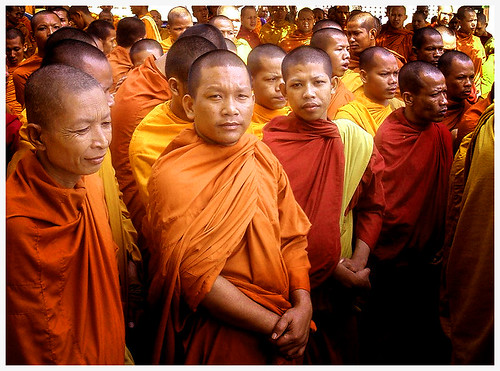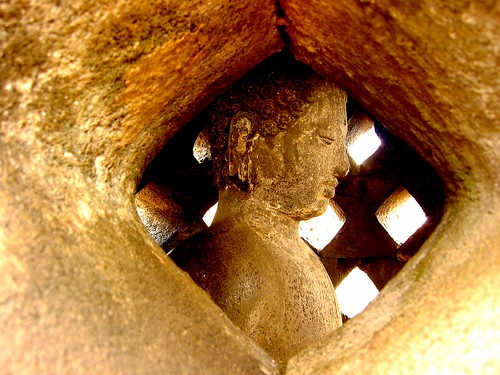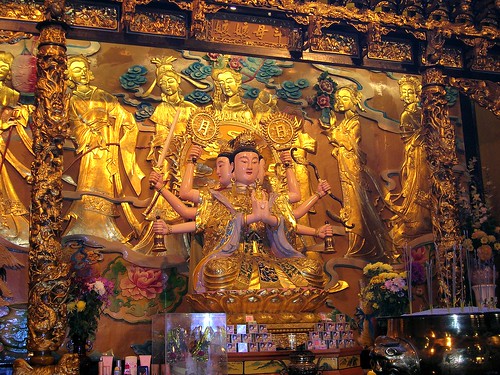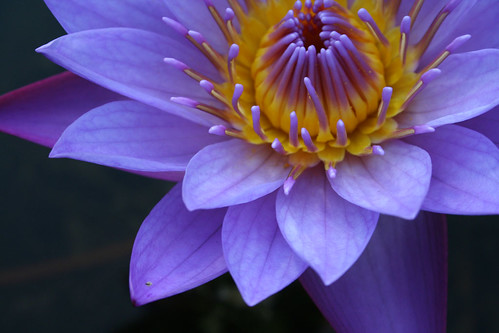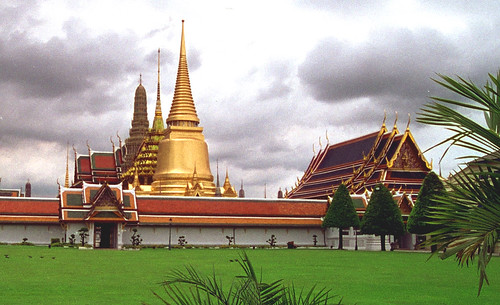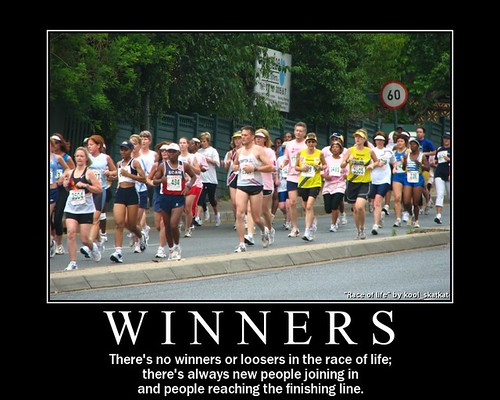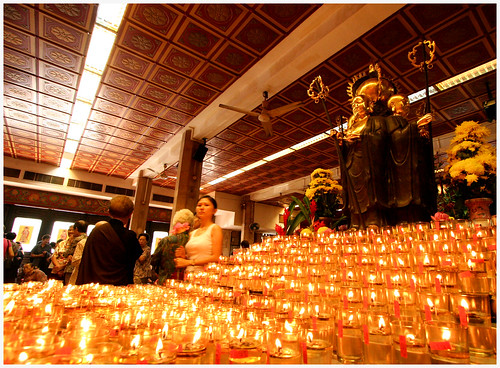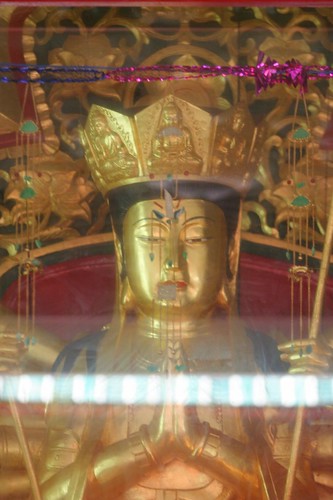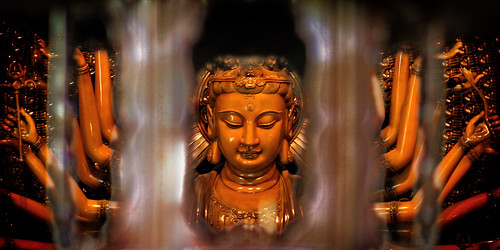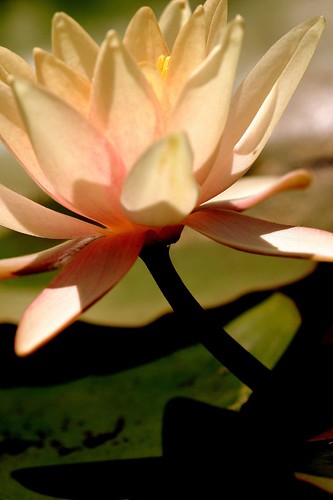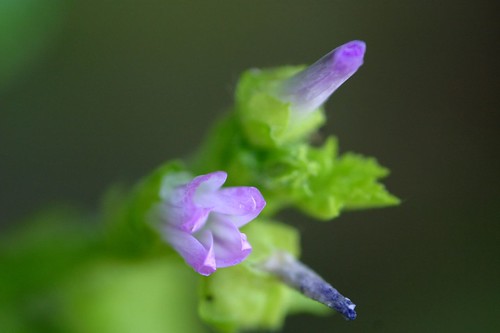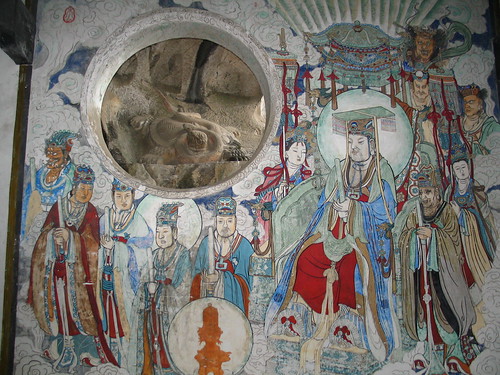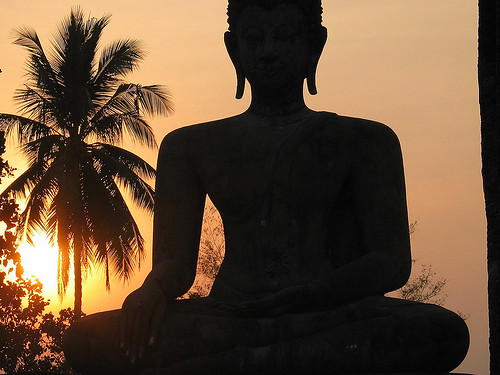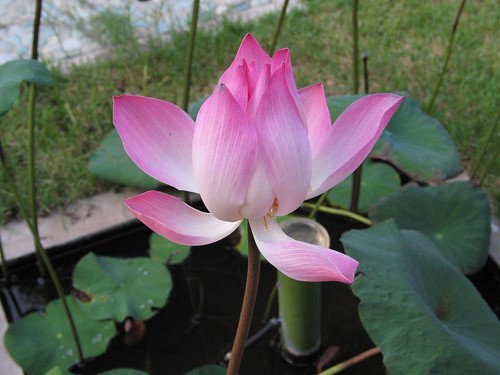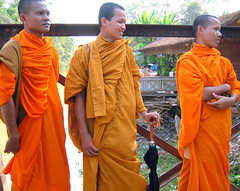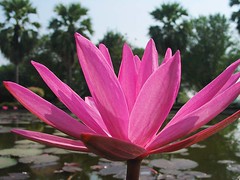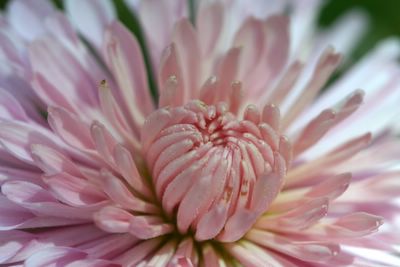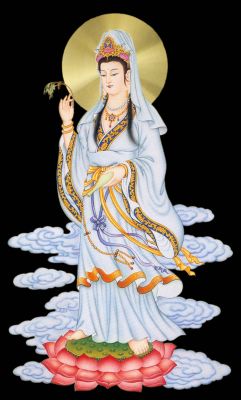This is a very colorful Monk's quarter in Lhasa.
Monday, December 26, 2005
Wednesday, December 21, 2005
All Being Are Equal
Gotama Buddha teaching is "All Beings Are Equal".
However, you see the robe of the Monk's they are differentiated by the color, to show that their status.
That is why Buddha foresees that 2,500 - 3,000 years after his enlightenment there would be no more division between lay people & monk's or Nan's!!
All Being Are Equal
Gotama Buddha teaching is "All Beings Are Equal".
However, you see the robe of the Monk's they are differentiated by the color, to show that their status.
That is why Buddha foresees that 2,500 - 3,000 years after his enlightenment there would be no more division between lay people & monk's or Nan's!!
Thursday, December 15, 2005
BoroBhuRo
The old Chinese Saying:
Saving one life is better than building a 7th step BoroBhuRo!!
What is the Wisdom behind??
Friday, December 09, 2005
Doumu Nian Nian 斗母娘娘
From the photo of this I can recognise the similarity with the Goddess of Mercy with Thounsands Hands & Thousands Eyes!!
In the legend, this goddess is the mother of the 9 emperors' Star's of the heaven.
According to my research, this have some infleunce from the Indian God Lord Siva!!
N.B.
Buddism evolved from Hinduism.
Thursday, November 17, 2005
Lotus Or Lily
The Gotama Buddha Said:
The Muddies Pond's would grow the Biggest & prettiest Lotus or Lily's!!
Monday, November 14, 2005
Pagoda
This photos shown the Pagoda or Stupa of the Hade Temple in Bangkok - Thailand!!
Pagoda or Stupa in Thailand temples' are used for the remains of the ashes of the priests' or Holy persons'.
Friday, November 11, 2005
Candle Wisdom
Do you know why Gotama Buddha advise us to offer Candle to Holy re;igious teachers' & at the Altar??
Well, the wisdom of a candle is just like one live cycle.
From light up a new candle to the Candle is burn off & light extinguished!! That is Like:
Birth
Growth
Decay
Death
The processes of BLive Cycle.
Tuesday, November 08, 2005
Winner & Loser
As Gotama Buddha Said:
All Being's Are Equal!!
Therefore,
There Is No Winner
&
There Is No Loser!!
Tuesday, November 01, 2005
Buddhissvathva of Great Filial
This is Mokalanat the Greastest Filial Buddhisvathva.
He have Vow in his life time that if the Hells are not destroyed he would not become the Budddha.
He also vow to salvage the suffering beings in hells or living hells.
Tuesday, October 25, 2005
Buddha Statue
I appreciate the craft of Thailand Buddha Statues more then the other is that:
Thai Buddha Statues are influenced by both the India & Sri-Lanka craftman works.
& it is just excellent art!!
Wednesday, October 05, 2005
Greatest Compassionate - Goddess of Mercy
Goddess of Mercy with Thousand hands & Thousand Eyes.
He/She have Vow that, in any corner of the Universe, He/She would look for the suffering beings & free them!!
Friday, September 30, 2005
Goddess of Mercy
Goddess of Mercy
I am posting this from by friend WayneMethod site.
Please read more about the comments on this Greatest Compationate Buddhisvatha.
Tuesday, September 13, 2005
What Buddha Said About Universe??
Yesterday, in the morning I am reading the book:
"The Buddha's Explaination of The Universe!!"
Today, I found this News:
Galaxy Exposion 12.6Billions Light-Years Away!!
Just imagine Buddha is 2,560 years ahead of these news!!
He is our greatest Guru!!
Sunday, June 26, 2005
What Is Life??
What Is Life??
In Gotama Buddha Words:
Just like the Dews On The Leaf In the Morning;
Just Like the Fogs In The Air....
Tuesday, June 07, 2005
FlowerWisdom
Sunday, May 15, 2005
Birth - Growth - Decay - Death
Birth
Growth
Decay
Death
is the 4 Noble Truth of Life!!
All Beings cannot escape these.
Friday, May 06, 2005
Sunday, May 01, 2005
Indra
Indra
The Name of the Jade Emperor In Dusitat ( 33th Heaven)
According to the Buddha:
Our Human earth is 200 years, Over in Dusitat there is 1 Day.....
Tuesday, April 26, 2005
Sukothai Buddha Statue
I have research into the Thai Buddism since 1980.
What I found is that Thai Buddha statue have lots of influence from India.
In fact the Chinese Version Buddha statue are fat then is symbolize wealth.
The Japanese Buddha statue are mainly influence by the Chinese craft.
After appreciating the Buddha statue arts in Various period s of Thai Buddism.
I am in the opinion that Sukothai Buddha Statue still is among the best Buddha Art after all.
Wednesday, April 20, 2005
Our Guru of Universes
He is The Greatest of All...
He Told Us The Truth
The 4 Noble Truth!!
He Show Us The Way
The 8 Fold Path!!
He Said, By Following His Way.....
All of Us Would Become Buddha
& Dwell in Nirvana..........
Saturday, April 16, 2005
Lotus Charater
What Did Buddha Said About The
Excellence Characteristic of Lotus??
The More Muddy,
The More Dirty the Pond,
The Biggest Is The Lotus!!
Thursday, April 14, 2005
Sleeping Meditation
Yes, That is part of the Buddha Teaching!!
You can:
Sit Meditation
Walk Meditation
Sleep Meditation
Most Importance Things is:
Mindfulness In Your Meditation.
Whatwever Position is just A physical body expression!!
Wednesday, April 13, 2005
Buddist Monks Robes
I didn't know thet Meaning behind.
Till One Day, I was sleeping beside my late godfather who is the Chief Abbot of his Thai Wat.
He said; it means that difference color are difference Ranking.
Then I said.. Did Buddha said:
All Beings Are Equal??
He Knock My Head & said:-
All dressed in The Same Color, then How To Identify.....
So.. what is the Wisdom Gained??...Nothing...Nothing...Nothing..Back to Nothing.....Nirvana...Peace...Peace...Peace.....
Monday, April 11, 2005
Why Lotus Is The Symbol of Buddhism
Grow Out of Muddy Pond,
Yet Maintence It's
Clean
Clear
Firm
Righteous
Elegant
Beauty
etc...
Saturday, April 09, 2005
Friday, April 08, 2005
Buddhist Songs In Mandarin - by Daniel Yeo
Adapted from:

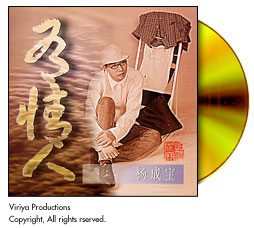
This is a collection of Chinese Buddhist Songs. All files are in MP3 format - please right click on the links and choose "Save Target As.." to save them. If you have quality audio material to contribute to this section, please contact us and we will include them here.
BuddhaNet Audio: Chinese Buddhist Songs (by Daniel Yeo)
Saturday, April 02, 2005
The Saying of The Buddha
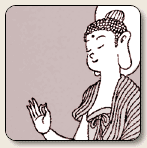

Who can fail to be profoundly moved by the words of the Buddha?
In this series of delightfully illustrated stories (there are 8 of them), the Buddha teaches us on the importance of Spiritual Cultivation.
Find out what the Buddha say about the Independent Self, the necessity of holding proper beliefs! Why you won't get anywhere on the Spiritual Path unless you actually practice, and much much more......


Wednesday, March 30, 2005
Goddess of Mercy Chant - Guan Yin Chant
According to Gotama Buddha, After he ascented to Nirvana, the 2 Buddhisvathvas would be in the trillions....of Universes salvaging suffering beings would Be :
1. Guan Yin -- The Goddess of Mercy
2. Ti Chang -- The Mines of Earth
Where Guan Yin Vow that if there is a voice of Suffering she would be there to free them from suffering..
Where Ti Chang Vow that if the Hells are not distroyed He would never become Buddha!!
I would share with you all the story on these...
The Mantra is Romanised Pali for you to Chant.
Guan Yin Prayer
观音咒
奉请观音大悲咒, 救渡众生无尽期。
左手取来功德水, 右手提着杨柳枝。
头顶顶载牟尼仪, 心里诚念陀罗尼。
古佛再来观世音, 千手千眼陀罗尼。
赐我神通智圆满, 赐我行得善方便。
赐我速得富庶种, 赐我除去一切厄。
赐我了断诸苦难, 赐我速住无为舍。
赐我了脱生死业, 赐我觅得智慧根。
赐我速登般若船, 赐我力证涅磐真。
古佛再来观世音, 千手千眼陀罗尼。
有人念得观音咒, 一切灾殃尽消散。
弟子念得观音咒。 刀山劫煞尽自撤。
火海自息化莲池 ,冤家仇敌化善友。
官非伽仗得平伸, 是非邪秽永不侵。
一切诸魔皆降服, 饥俄贫穷化富足。
家眷和谐大和气, 身心康泰勤精进。
心想事成大欢喜, 金银财宝满盈盈。
古佛再来观世音, 千手千眼陀罗尼。
弟子念得观音咒, 地狱自化为净土。
修罗自悟自调伏, 饿鬼自填自饱满。
畜牲自得大智慧。
蓬莱山,西海岸, 普陀山,洛伽洞,
梵音洞,潮音洞, 不肯去,紫竹林,
五方五土观世音, 五湖四海观世音,
虚无飘缈观世音, 虚空藏中观世音,
小千世界观世音, 中千世界观世音,
大千世界观世音, 三千大千观世音,
速来授手,救苦救难, 人佛一心,
人离难, 难离身, 苦离心,
一切灾殃尽化尘。
揭帝,揭帝,
巴拉蜜佛陀揭帝,
巴拉蜜达摩揭帝,
巴拉蜜僧伽揭帝,
菩提萨哆呀。
Chedi, Chedi, Chedi,
Parami Buddho Chedi,
Parami Dhammo Chedi,
Parami Sangkho Chedi,
Buddhisvathvaya.
Arahan Samma SamBhuddho Bagava,
Buddham Bhagavadha Abiva Demiv,
Suvagato Bhagavadha Dhammo,
Dhammong Namacami,
Supati Panno Bhagavadho,
Saravaka Sangkho,
Sangang Namami.
Satu Satu Satu!!!!!!
The English Translation would be follow on my future posting
Saturday, March 26, 2005
Red Traffic Light - Be Mindful Buddha is Present!!
When we do walking meditation, the point is not to get somewhere, but rather to practice, using walking as the object of our attention. Even when we do have to get somewhere and must drive to do so, there is an opportunity for practice. Thich Nhat Hanh, Vietnamese Zen master and poet, has written a number of gathas, or brief verses, for enhancing our mindfulness during everyday activities, even driving a car.
Before starting the car, I know where I am going. The car and I are one. If the car goes fast, I go fast.
If we are mindful when we start our car, we will know how to use it properly. When we are driving, we tend to think of arriving, and we sacrifice the journey for the sake of the arrival. But life is to be found in the present moment, not in the future. In fact, we may suffer more after we arrive at our destination.
If we have to talk of a destination, what about our final destination, the graveyard? We do not want to go in the direction of death; we want to go in the direction of life. But where is life? Life can be found only in the present moment. Therefore, each mile we drive, each step we take, has to bring us into the present moment. This is the practice of mindfulness.
When we see a red light or a stop sign, we can smile at it and thank it, because it is a bodhisattva helping us return to the present moment. The red light is a bell of mindfulness. We may have thought of it as an enemy, preventing us from achieving our goal. But now we know the red light is our friend, helping us resist rushing and calling us to return to the present moment where we can meet with life, joy and peace. Even if you are not the driver, you can help everyone in the car if you breathe and smile.
A number of years ago, I went to Canada to lead a retreat, and a friend took me across the city of Montreal. I noticed that every time a car stopped in front of me, I saw the sentence, "Je me souviens" ("I remember"), on the license plate. I did not know what they wanted to remember, perhaps their French-speaking origin, but it gave me an idea.
I told my friend, "I have a present for all of you here. Every time you see a car stop in front of you with the line 'Je me souviens,' you can see it as a bell of mindfulness helping you remember to breathe and smile. And you will have plenty of opportunities to breathe and smile while driving in Montreal."
My friend was delighted! He liked it so much that he shared the practice with more than 200 people in the retreat. Later, when he came to visit me in France, he told me that Paris was not a good place to practice driving, as there were no signs "Je me souviens." I told him that he could practice with red lights and stop signs.
After he left Plum Village and went back to Montreal, he wrote me a beautiful letter: "They, practicing in Paris was very easy. Not only did I practice with red lights and stop signs, but every time a car stopped in front of me, I saw the eyes of the Buddha blinking at me. I had to smile at those blinking eyes."
The next time you are caught in traffic, don't fight. It is useless to fight. If you sit back and smile to yourself, you will enjoy the present moment and make everyone in the car happy. The Buddha is there, because the Buddha can always be found in the present moment.
Practicing meditation is to return to the present moment in order to encounter the flower, the blue sky, the child, the brilliant red light
Wednesday, March 23, 2005
Alien Planets Show Themselves for First Time
Buddha in his "Explanation of The Universe" said How the Universe were formed. & there are atleast 73 planes of existence in the whole great universe. Ther are bilions...billions.....billions of Universes.
In each plane the times & spaces are difference from the human plane. He use the Animals & insects as the example.
Well there are lots of things that Buddha touch on these topic. I will share with you all here.
Alien Planets Show Themselves for First Time
By DENNIS OVERBYE Published: March 23, 2005
Astronomers said yesterday that they, or at least their telescopes, had laid eyes for the first time on planets beyond the solar system.
Using the NASA Spitzer Space Telescope and careful timing, teams studying two planets were able to distinguish the glow of the planets' infrared radiation from the overwhelming glare of their parent stars. Both planets are so-called hot Jupiters, massive bodies circling their stars in tight, blowtorching orbits and probably unfit for the kind of life found on Earth.
Until now, astronomers could infer the existence and some properties of these and other so-called exoplanets only by indirect means. They said directly measuring light from the planets was a major step in the quest to understand what alien planets are made of, because different molecules in the atmosphere absorb infrared light in characteristic ways and allow scientists to compare these alien planets to those in the solar system. Ultimately, astronomers would like to know if Earth, with its ability to evolve and support life, is unique or common in the universe.
Dr. David Charbonneau of the Harvard-Smithsonian Center for Astrophysics, who led one of the teams, said he was ecstatic when he first saw the data. "We've been hunting for this light for almost 10 years, ever since extrasolar planets were first discovered," Dr. Charbonneau said.
The Harvard-Smithsonian team and the other team, led by Dr. L. Drake Deming of the Goddard Space Flight Center, announced their results at a news conference at the headquarters of the National Aeronautics and Space Administration in Washington. The Deming team's paper was published online yesterday by the journal Nature; the other team will publish its results in The Astrophysical Journal on June 20.
Dr. Geoffrey W. Marcy, a planet hunter at the University of California, Berkeley, called the results "the stuff of history books" and added, "With this result, we are closer to understanding our own human roots, chemically, among the stars."
Dr. Alan P. Boss, a planetary theorist at the Carnegie Institution of Washington, said in an e-mail message that the discoveries showed "that we are well along the way to combining astronomy and biology into the new science of astrobiology, with the ultimate goal being to search for life beyond Earth."
About 130 planets are known to orbit other stars, but until now they have all been detected indirectly, either by the wobble their gravity induced in the motions of their parent stars or by slight dips in the stars' light when their planets passed in front of them.
The planets whose discoveries were reported yesterday fall in the latter category, passing directly in front of their parent stars periodically and then behind them. The Goddard team's object, known as HD 209458b, was the first planet detected by the so-called transit method, back in 1999. It circles a star about 153 light-years away in the constellation Pegasus, making a complete trip every 3.5 days. In 2001, Dr. Charbonneau used the Hubble Space Telescope to make spectroscopic measurements of this star while the planet was passing in front of it and found that sodium and hydrogen were present in the planet's atmosphere.
The other planet, known as TrES-1 after the telescope network that discovered it, the Trans-Atlantic Exoplanet Survey, is about 500 light-years away in the constellation Lyra. Discovered last year by a telescope only four inches in diameter, it circles its parent every three days.
In both cases the astronomers were able to use the special geometry of these planetary systems to tease out the faint light of each planet from its parent's glare, comparing measurements made while the planet and star were both visible and while the planet was hidden behind the star. It helped that the Spitzer telescope, launched in 2003, was built to study infrared radiation, which has a longer wavelength than visible light. Because they are so close to their stars, these planets were expected to be hot and therefore show up more easily at infrared wavelengths than in the visible light. While the stars outshine such giant planets by a factor of 10,000 or so in visible light, they are only about 400 times brighter in infrared.
When the astronomers put on their "infrared goggles," as Dr. Charbonneau put it, the planets popped into view. The Spitzer telescope registered a dip in light of about a quarter of 1 percent in each case when the planet went behind its star.
That dip was enough to allow the astronomers to take the temperature of these planets and confirm that they are hot, as predicted: about 1,450 degrees Fahrenheit for TrES-1 and about 1,570 degrees for HD 209458b.
Other results were more puzzling. The TrES-1 planet seems to be emitting less light at shorter infrared wavelengths than the models of such planets predict, Dr. Charbonneau said, perhaps because greater-than-expected amounts of carbon monoxide are absorbing those wavelengths.
But as Dr. Charbonneau said, theoretical predictions about extrasolar planets have turned out to be "nothing short of disastrous." The field, he said, is driven by data, and there has not been much of that until now.
Dr. Boss said the Spitzer telescope had been designed decades ago and was never intended to study extrasolar planets. He also said that NASA had a whole menu of "wonderful" planet-finding missions.
"Just think of the results we will have from NASA's future telescopes that will be specifically designed to detect and study extrasolar planets," he said.
The New York Times > Science > Alien Planets Show Themselves for First Time
Tuesday, March 22, 2005
A Guided Breathing Meditations
(Theravadin)
SIT COMFORTABLY ERECT, without leaning forward or backward, left or right. Close your eyes and think thoughts of good will. Thoughts of good will go first to yourself, because if you can't think good will for yourself—if you can't feel a sincere desire for your own happiness—there's no way you can truly wish for the happiness of others. So just tell yourself, "May I find true happiness." Remind yourself that true happiness is something that comes from within, so this is not a selfish desire. In fact, if you find and develop the resources for happiness within you, you're able to radiate it out to other people. It's a happiness that doesn't depend on taking away anything from anyone else.
So now spread good will to other people. First, people who are close to your heart—your family, your parents, your very close friends: May they find true happiness as well. Then spread those thoughts out in ever widening circles: people you know well, people you don't know so well, people you like, people you know and are neutral about, and even people you don't like. Don't let there be any limitations on your good will, for if there are, there will be limitations on your mind. Now spread thoughts of good will to people you don't even know—and not just people; all living beings of all kinds in all directions: east, west, north, south, above, and below, out to infinity. May they find true happiness, too.
Then bring your thoughts back to the present. If you want true happiness, you have to find it in the present, for the past is gone and the future is an uncertainty. So you have to dig down into the present. What do you have right here? You've got the body, sitting here and breathing. And you've got the mind, thinking and aware. So, bring all these things together. Think about the breath and then be aware of the breath as it comes in and goes out. Keeping your thoughts directed to the breath: that's mindfulness. Being aware of the breath as it comes in and out: that's alertness. Keep those two aspects of the mind together. If you want, you can use a meditation word to strengthen your mindfulness. Try "buddho," which means "awake." Think "bud-" with the in-breath, "dho" with the out.
Try to breathe as comfortably as possible. A very concrete way of learning how to provide for your own happiness in the immediate present—and at the same time, strengthening your alertness—is to let yourself breathe in a way that's comfortable. Experiment to see what kind of breathing feels best for the body right now. It might be long breathing, short breathing; in long, out short; or in short, out long. Heavy or light, fast or slow, shallow or deep. Once you find a rhythm that feels comfortable, stay with it for a while. Learn to savor the sensation of the breathing. Generally speaking, the smoother the texture of the breath, the better. Think of the breath not simply as the air coming in and out of the lungs, but the energy flow that courses through the body with each in-and-out-breath. Be sensitive to the texture of that energy flow. You may find that the body changes after a while. One rhythm or texture may feel right for a while, and then something else will feel more comfortable. Learn how to listen and respond to what the body is telling you right now. What kind of breath energy does it need? How can you best provide for that need? If you feel tired, try to breathe in a way that energizes the body. If you feel tense, try to breathe in a way that's relaxing.
If your mind wanders off, gently bring it right back. If it wanders off ten times, a hundred times, bring it back ten times, a hundred times. Don't give in. This quality is called ardency. In other words, as soon as you realize that the mind has slipped away, you bring it right back. You don't spend time aimlessly sniffing at the flowers, looking at the sky, or listening to the birds. You've got work to do: work in learning how to breathe comfortably, how to let the mind settle down in a good space here in the present moment.
When the breath starts feeling comfortable, you can start exploring it in other areas of the body. If you simply stay with the comfortable breath in a narrow range, you'll tend to doze off. So consciously expand your awareness. A good place to focus first is right around the navel. Locate that part of the body in your awareness: where is it right now? Then notice: how does it feel there as you breathe in? How does it feel when you breathe out? Watch it for a couple of breaths, and notice if there's any sense of tension or tightness in that part of the body, either with the in-breath or with the out-breath. Is it tensing you up as you breathe in? Are you holding on to the tension as you breathe out? Are you putting too much force on the out-breath? If you catch yourself doing any of these things, just relax. Think of that tension dissolving away in the sensation of the in-breath, the sensation of the out-breath. If you want, you can think of the breath energy coming into the body right there at the navel, working through any tension or tightness that you might feel there...
Then move your awareness to the right—to the lower right-hand corner of your abdomen—and follow the same three steps there: 1) locate that general part of the body in your awareness; 2) notice how it feels as you breathe in, how it feels as you breathe out; and 3) if you sense any tension or tightness in the breath, just let it relax . . . . Now move your awareness to the left, to the lower left-hand corner of your abdomen, and follow the same three steps there.
Now move your awareness up to the solar plexus . . . . and then to the right, to the right flank . . . . to the left flank . . . . to the middle of the chest . . . . After a while move up to the base of the throat . . . . and then to the middle of the head. Be careful with the breath energy in the head. Think of it very gently coming in, not only through the nose, but also through the eyes, the ears, down from the top of the head, in the back of the neck, very gently working through and loosening up any tension you may feel, say, around your jaws, the back of your neck, around your eyes, or around your face...
From there you can move your attention gradually down the back, out the legs, to the tips of the toes, the spaces between the toes. As before, focus on a particular part of the body, notice how it feels with the in-breath and out-breath, relax any sensation of tension or tightness you might feel there, so that the breath energy can flow more freely, and then move on until you've reached the tips of the toes. Then repeat the process, beginning at the back of the neck and going down the shoulders, through the arms, past your wrists, and out through your fingers.
You can repeat this survey of the body many times until the mind settles down.
Then let your attention return to any spot in the body where it feels most naturally settled and centered. Simply let your attention rest there, at one with the breath. At the same time let the range of your awareness spread out so that it fills the entire body, like the light of a candle in the middle of a room. Or like a spider on a web: the spider's in one spot, but it knows the whole web. Be keen on maintaining that broadened sense of awareness. You'll find that it tends to shrink, like a balloon with small hole in it, so keep broadening its range, thinking "whole body, whole body, breath in the whole body, from the top of the head down to the tips of the toes." Think of the breath energy coming in and out of the body through every pore. Make a point of staying with this centered, broadened awareness as long as you can. There's nothing else you have to think about right now, nothing else to do. Just stay with this centered, broadened awareness of the present...
When the time comes to leave meditation, remind yourself that there's a skill to leaving. In other words, you don't just jump right out. My teacher, Ajaan Fuang, once said that when most people meditate, it's as if they're climbing a ladder up to the second story of a building: step-by-step-by-step, rung-by-rung, slowly up the ladder. But as soon as they get to the second story, they jump out the window. Don't let yourself be that way. Think of how much effort went into getting yourself centered. Don't throw it away.
The first step in leaving is to spread thoughts of good will once more to all the people around you. Then, before you open your eyes, remind yourself that even though you're going to have your eyes open, you want your attention to stay centered in the body, at the breath. Try to maintain that center as long as you can, as you get up, walk around, talk, listen, whatever. In other words, the skill of leaving meditation lies in learning how not to leave it, regardless of whatever else you may be doing. Act from that sense of being centered. If you can keep the mind centered in this way, you'll have a standard against which you can measure its movements, its reactions to the events around it and within it. Only when you have a solid center like this can you gain insights into the movements of the mind.
Friday, March 18, 2005
Kalama Sutra
Buddha said:
Do not believe in Logic
Do not believe in anything simply because you have Hearsay.
Do not believe in Traditions because they have been Handed down for Many Generations.
Do not believe anything because it is Spoken and Rumored by Many.
Do not believe in anything because it is Written in your Religious Books.
Do not believe in anything Merely on the Authority of your Teachers and elders.
But after Mindful Observation and Analysis, when you find that anything Agrees with Reason’s and is Conducive to the Good and the Benefit of One and All, then Accept it and Live up to It.
Wednesday, March 16, 2005
Saturday, March 12, 2005
Talk About Kalama Sutra
I shall gives the full version in my next post.
The Kalama Sutra
Anthony Flanagan,Your Guide to Buddhism.
Once, the Buddha was traveling through the region of Kosala inhabited by a group of people known as the Kalamas. When he came to the town of Kesaputta he was approached by a number of Kesaputtians who asked him a question which is as relevant today as it was then. The essential question was this: 'When we are presented with an array of different views on the nature of truth, with teachers claiming that theirs is the one and only way, which are we to believe?
The Buddha's response is captured in this key passage:
'do not be satisfied with with hearsay or with tradition or with legendary lore or with what has come down in your scriptures or with conjecture or with logical inference or with weighing evidence or with liking for a view to pondering over it or with someone else's ability or with the thought "The monk is our teacher"'.
But this passage has to be seen in the context of the whole sutra.
The Buddha advises the Kesaputtians not to accept any teaching when they know that it is 'unwholesome, liable to censure, condemned by the wise, being adopted and put into effect they lead to harm and suffering'. The kalama sutra, therefore, is an important one in that it directs us not to follow any teaching blindly but to test it out against clearly defined criteria.
For example, are its ideas wholesome, do they accord with the teachings of the wisest teachers, do they lead to one's own suffering or the suffering of others?
The Kalama Sutra - Printer Friendly
Thursday, March 10, 2005
Wednesday, March 09, 2005
Tuesday, March 08, 2005
Bodhidharma 470 -- 543
His Holiness The First Patriarch of Chinese Zen Lineage
He is the founder of Zen Buddhism. When he arrived in China, it is known that he went to the cave in Shao Lin Temple & Meditate for 10 years, without speaking a single words.
Bodhidharma is credited with bringing Zen Buddhism to China and he is the First Patriarch of Chinese Zen Lineage. He was born on Oct. 5th. (Chinese Lunar Calendar) in Southern India, and was the third son of an Indian King; the royal family belonged to the Bhramin caste.
Bodhidharma's Buddhist Master, Prajnatara, was the 27th Patriarch of Indian Buddhism, taught Bodhidharma for many years, gave him Mind Transmission, made him the 28th Patriarch, and gave him the name Bodhidharma.
Following the instruction of his Master to transmit Dharma to China, Bodhidharma traveled east to Southern China in 526 A.D. When he arrived in Kwang Chou, he was ceremoniously welcomed and greatly honored by the local military official named Shao Yang.
The same year, he was invited to the Capitol, Nanjing, to meet Emperor Wu Di of the Liang dynasty. Because the communication between the Emperor and Bodhidharma was mutually unsatisfactory, Bodhidharma left the palace, crossed the Yangtzu River, and continued north until he arrived at the Shao Lin Temple in Ho Nan Province. It was here that Bodhidharma became famous for meditating 9 years facing a wall.
After he gave his disciple, Hui K'o, the Robe, Begging Bowl, Lankavatara Sutra, and Mind Transmission, Bodhidharma went to Chen Sung (One Thousand Saints) Temple to propagate the Dharma. He passed into Nirvana in 536 A.D., was buried in Shon Er Shan (Bear Ear Mountain) in Ho Nan, and a stupa was built for him in Pao Lin Temple.
Later, the Tang dynasty Emperor, Dai Dzong, bestowed on Bodhidharma the name Yuen Che Grand Zen Master, and renamed his stupa as Kong Kwan (Empty Visualization).
Bodhidharma's Teachings:
Bodhidharma instructed his disciples that the Lankavatara Sutra be used to seal the mind. The method of cultivating practice transmitted by Bodhidharma pointed out that we should pay attention closely to this important sutra.
His major teaching is there are two paths to enter Dharma Gate: Study and Practice.
Study:
Through the study of Buddhist sutras and scriptures, you will understand Buddha Nature. Your Buddha Nature doesn't manifest because it is clouded by defilements, such as: greed, attachment, passion, aggression and ignorance.
Practice:
When you follow Buddhist principles in your daily life, you discover that your Buddha Nature is equal to the Buddha's.
1. Bao Yen Hsin: The willingness to accept, without complaining, suffering and unhappiness because you understand it is your own karma.
2. Sui Yen Hsin: Understanding that all situations are the consequences of karmic causes, and therefore, you maintain equanimity in all circumstances, both negative and positive.
3. Tsung Fa Hsin: Realizing through practice the essence of your Buddha Nature, which is equanimity.
Wednesday, March 02, 2005
Where Are We From?? Planet of Lights & Sound!!
According to Buddha in his Fa Hua Sutra &
Goddess of Mercy - Kuan Yin Sutra
We all living beings are originated from the Plane of Kwang Yin the Heavens of Lights & Sounds;
It is about atleast few thousands billions MK light years away from this universe & our present earth.
We have no Physical body, we don't have the blood & fresh... therefore there is not physical illness or needs to eat or drinks.
What we are today is because we dell in our present on earth & enjoying the taste of the Garbages & Drinks on earth that is what we are,
subject to:
Birth
Growth
Decay
Death
The wheel of Birth & Death!!
The Buddha teaching of become a Enlighten One, the Buddha is based on his own path that he learn & he have walk through!!
Now you can find out Buddhism knowledge by do a search on:
Yahoo
MSN
You would discover more....
Sunday, February 27, 2005
Psychotherapy - Mindfulness Meditation
for both Physic & Physical therapy.
My observation is that Buddha teaching of Mindfulness
is further afirm his Theory of thr 4 Noble truth.
And about Birth - Growth - Decay - Death
The truth about
Birth & Rebirth for Physic & Physical.
All beings including the Billions & Trillions
or Universe cannot escape from the truth of
Birth & death cycle.
By Mindfulness Meditations & making
peace & blessing the billions of lilives within the
Human own universe, the illness be it in Physic &
Physical matters are cease to null.
In the Buddha teaching all those Sutra aspecially
the High Blessing.. it exhibit that Buddha wisdom of
protection & highest blessing.
....By The Power of The Buddhas May All Be Well......
......By The Power of The Buddha Teaching May All Be Well...
.....By The Power of The Holy Priest's May All Be Well....
A Buddhist Approach to Psychotherapy
Story by Kathy Vozella Photo by Michelle Wilson,
Macqurie University (Australia),
Email the researcher: bkhong@psy.mq.edu.au, Oct 26, 2004
Sydney, Australia -- Incorporating Buddhist
ideas and philosophy into psychotherapy is not new -
meditation has been used for some time as a form of
relaxation and a way of helping an individual
understand the workings of the mind.
However, according to one Macquarie University
researcher, meditation can be used for personal growth
beyond therapy if it is understood against the backdrop
of the Buddha's teachings and integrated holistically
with psychotherapy.
Dr Belinda Siew Luan Khong, lecturer in the Department
of Psychology, is quick to point out that she is not
a Buddhist, but she is informed by the Buddha's
teachings. Her PhD thesis titled A Comparative Analysis
of the Concept of Responsibility in Daseins analysis and
Buddhist Psychology received a Vice-Chancellor’s
Commendation and won her the Sidney M Jourard Memorial
Student Award for outstanding research from the American
Psychological Association (APA) in 1999.
Since graduating with her PhD in 1999, Khong has been
teaching part-time at Macquarie University, operating
her own counseling practice and traveling the world
presenting papers and conducting workshops on the
integration of Buddhist psychology and philosophy
in psychotherapy. She recently returned from the APA
Annual Convention in Hawaii where she presented a paper
on Personal growth in and beyond therapy.
“I believe that the Buddha teaches an attitude
rather than an affiliation,” Khong writes in
a chapter of Encountering Buddhism: Western psychology
and Buddhist teachings. “This state of mind can
be acquired by any individual irrespective of his or her
race, culture or religious orientation.” Khong
remains one of the few psychotherapists worldwide to
integrate Buddhist teachings whenever appropriate into
the counseling process and beyond.
The ‘beyond therapy’ aspect is something she emphasizes,
as many of her clients say that when they finish their
counseling with her they take away a general philosophy
for life, a way of responding appropriately which they
can apply to various situations as they arise.
“Buddhist ideas and practices have been
integrated in therapy for some time,” she says.
“However the main focus
has been on the use of meditation and mindfulness as an
adjunct to therapy.
In my clinical work I have found these practices to be
more helpful and effective when they are understood
holistically in the context of the Buddha’s teachings.”
Khong explains that the Buddha promotes an
attitude of acceptance and letting go developed
through personal effort and taking personal responsibility
rather than through relying on an external source
or orientation.
“The human qualities and emotions that the
Buddha encourages such as love, charity, compassion,
tolerance and patience are not sectarian as they are
neither Christian, Buddhist, Hindu nor Muslim.
They come from developing the right attitude,
not the right affiliation,” she says.
The Buddha encourages insight and understanding based
on direct experience, and this is emphasized in his
teaching of the eightfold path:
Morality Mental culture Wisdom
Right Speech
Right Effort
Right Understanding
Right Action
Right Mindfulness
Right Thought
Right Livelihood
Right Concentration
Khong explains that in this teaching, the Buddha is
describing a set of practices rather than a set of
beliefs that the individual can use to overcome his
or her own emotional suffering. “For example the Buddha
recommends that each of us take the responsibility to
cultivate an attitude (right understanding, right
thought) of seeing what is an appropriate response
(right action, right speech, right livelihood) in each
situation,” she says.
“Most of us are familiar with the power of
speech to hurt or soothe.
There will be times when friendly and meaningful
advice are helpful and other times when keeping
‘noble silence’
is appropriate.” Two types of meditation are
commonly practiced today.
The first type, known as concentration or
tranquility meditation, encourages the
individual to let go of negative thoughts that impinge
by concentrating on one neutral object to the exclusion
of all others. This is a popular tool used in
psychotherapy to help the individual to quieten down
the mind and to relax. The second type, known as insight
meditation or mindfulness practice, is unique to Buddhism
and is often used to complement concentration meditation.
Dr Belinda Khong, explains that once you calm down the
mind you still need to deal with the feelings and
emotions that come up. Mindfulness practice encourages
the person to be mindful of whatever enters the mind.
“Mindfulness helps us to look at all the feelings
and emotions as they arise, to name them, to see anger as
anger and sadness as sadness without judging them or
repressing them or carrying on an internal dialogue
(‘Why do I feel like this’, or ‘I shouldn’t feel so angry’).
The practice of mindfulness teaches the art
of acceptance and letting go, the key elements in the
attitude that the Buddha encourages,” Khong says.
“Through mindfulness
you can see what is really triggering off your own
feelings and emotions without allowing them to spiral.
“ When you are not mindful you react.
When you are mindful, you respond.
This kind of attitude is the most powerful tool my
clients take away from counseling because it gives them
choice – when you are mindful you can choose when you want
to be angry or depressed because it gives you the emotional
distance from the problem before you become reactive,”
she says. The distinction between responsibility and what
Khong refers to as ‘respond-ability’ is an important one.
Responsibility is usually associated with roles and positions,
and is commonly perceived in terms of duties, obligations
and accountability. Respond-ability, she explains, refers
to our internal ability to respond appropriately and
skillfully to what is required in each unique situation.
It involves the capacity to be mindful and to see and
understand things as they really are. “The idea
of learning to respond appropriately lies at the heart
of the Buddhist approach to responsibility,” she says.
Having experienced the powerful transformation of many
clients by using a combination of counseling and
mindfulness practice to various psychological concerns
including the prevention of the relapse of depression,
managing stress, interpersonal relationships and
personal growth, Khong is keen to integrate eastern
philosophies into more areas of western psychology.
In June next year, she will present a paper on
Complementing Cognitive Behavioral Therapy with Buddhist
Psychology at the IX World Congress on
Constructivism in Sweden, where his Holiness, the Dalai
Lama and Professor Aaron T Beck, the originator of
cognitive behavioral therapy, will be keynote speakers.
One of her current research interests involves extending
the work of colleagues and researchers in the US, the UK
and The Netherlands who are studying the
emotional and brain functioning (via functional MRI imaging)
of people using mindfulness practice. Khong is looking
at possible counseling applications and at ways of helping
individuals improve their general sense of well being.
“When mindfulness is practiced alongside other
complementary therapeutic approaches, the result is an
incisive and powerful tool for empowering clients to
understand and deal with their problems with less reliance
on the therapist,”Khong Says.
Monday, February 21, 2005
A Buddhist Perspective on Vegetarianism - No Killing Please!!
& Merits of Be A Vegetarian.
To sum up, Buddha Teaching
is No Killing!!
Any form of Killing would generate bad Karma for one life.
As reported in many recent research reports, mice..dog..
cat..pig do shares the origin of Human DNA.
So What Buddha have teach us some 2,5XX years ago on the
truth of animal can rebirth to Human, & Human Can Rebirth
to Animal is something really unbelievable, consider at
the time without the modern sciences & technology.
A Buddhist Perspective on
Vegetarianism
by Lin Ching Shywan, International Vegetarian Union, http://www.ivu.org/religion/articles/buddhist.html,
San Francisco, USA -- I have been a strict vegetarian for
more than four years now. When I first gave up meat, quite
a few of my friends and relatives expressed concern; most
people seem to have the idea that vegetarian food lacks
adequate nutrients.
And being vegetarian can be a more than minor inconvenience
with the amounts of meat and fish that people now eat.
Chinese have a traditional notion that foods that are
"warming" in nature,
like meat, are important for building up physical strength;
so in the minds of some of the older generation, one could
not possibly get all the nutrition one needed form the
"cool" bean greens,
white radishes, and so forth that vegetarians favor.
In their book, the only things that strengthen the body
are foods like tiger phallus, snake blood, stewed chicken
and crab in wine.
Before taking the big step, I didn't give nutrition,
convenience, or building up physical strength a second
thought, since my reason for becoming vegetarian had
nothing to do with any of these. I became vegetarian
because of my belief in Buddhism.
Why do Buddhists advocate vegetarianism? The main reason
is "mercy", and because we
"cannot bear to eat the flesh of living creatures."
And our belief in karma tells us that we must eventually
suffer the consequences of our evil actions. A Buddha sutra
says: "The bodhisattva fears the original action; the myriad
of living creatures fear the consequences."
This means that the bodhisattva knows the seriousness of the
consequences and does not do evil things; neither does he
think about the causes of bad consequences. Finally, I also
believe that a vegetarian diet better enables one to keep a
pure body and mind and this purity is an important foundation
of self-cultivation. My conversion to vegetarianism was based
on these three considerations.
"Mercy" is an
important way of learning to be a better person. Being
without mercy is simply incompatible with being a Buddhist.
Having a merciful and compassionate heart will show up in
all aspects of one's life; but the simplest and most
direct way is to follow a vegetarian diet. Think of the
intense pain of accidentally stepping on a nail is. So
how can one have the heart to eat the flesh of creatures
who have suffered the pain of being slaughtered, skinned,
dismembered, and cooked? Being unable to bring ourselves
to eat the flesh of these poor creatures is an expression
of mercy.
The pain of creatures on the road to our table is not
some fanciful concoction; it is excruciatingly real.
Let us cite the cooked live shrimp and crab that are so
popular today as an example. Meeting their end by being
cooked in water is like being sent to a boiling hell.
Their desperate but doomed efforts to crawl or jump out
betray the unbearable pain they experience.
Finally they give their life in sorrow as they turn bright
red. What a painful end!
Frogs are put through even more suffering than shrimp and
crabs. From the first made in their bodies to the time
they are swallowed they go through the equivalent of
eight different hells:
1. Decapitation;
2. Skinning;
3. Removing the legs;
4. Slitting of the belly;
5. Frying or boiling;
6. Salt, sugar and seasoning;
7. Chewing; and
8. Digestion
9. Excretion.
Anyone who put himself in take place of a frog would
be unable to ever stomach another one.
Among the different kinds of suffering the human race
can experience, the most intense is certainly that of
war. Documentaries of the Nanking massacre and the
Nazi holocaust leave few people unmoved and dry-eyed-and
most indignant. But humans can go for years or decades
without war; animals face suffering and death every day.
For meat eaters, every banquet means the death of hundreds
and thousands of animals. Is this any different from
human war?
Preventing the suffering of living creatures by not
using their flesh to satisfy our tastebuds and hunger
is the minimal expression of compassion we can offer.
We choose not to kill out of kindness, and not to eat
out of compassion.
I felt deeply moved upon reading two stories on the theme
of mercy; they will be etched forever in my memory. One is
recorded in the book "Record of Protecting Life":
When a scholar named
Chou Yu was cooking some eel to eat, he noticed
the one of the eels bending in its body such that its
head and tail were still in the boiling point liquid,
but its body arched upward above the soup. It did not
fall completely in until finally dying.
Chou Yu
found the occurrence a strange one, pulled out
the eel, and cut it open. He found thousands of eggs
inside. The eel had arched its belly out of the hot
soup to protect its offspring. He cried at the sight,
sighed with emotion, and swore never to eat eel.
This story tells us that the myriad living creatures
are not without feeling and intelligence.
Another story in recorded in Buddha sutra.
A king of heaven was stalemated in a war with a demon,
and neither side emerged as winner. As the king of heaven
was leading his soldiers back, he saw the nest of a golden
-winged bird in a tree by the roadside. "If the soldiers
and chariots pass by here, the eggs in the nest will
certainly fall to the ground and be scattered," he
thought to himself. So he led his thousand chariots back
the same road by which they came. When the demon saw
the king of heaven returning, he fled in terror.
The sutra's conclusion was that
"if you use mercy to
seek salvation, the lord of heaven will see it."
This story tells us that mercy may not seem like much
at first glance, but it is in fact extremely powerful.
The Buddha sutras frequently mention "the power of mercy,"
from this we know that mercy is indeed a potent force.
If a Buddhist wants to learn to use this strength of
mercy, he must be like the king of heaven in this story,
and be ready to change the route of a thousand chariots
rather than let a nest full of bird eggs fall to the ground.
The Surangama Sutra tells us
"if we eat the flesh of
living creatures, we are destroying the seeds of
compassion." That is, if we do not eat the flesh
of living creatures, we are cultivating and irrigating
the seeds of compassion," and to "cultivate a
compassionate heart," I chose to become a vegetarian;
and this is my main reason for doing so.
In Buddha teaching, volume upon volume has been written
regarding cause and consequence, but the basic concept
is a simple one. "Good is rewarded with good; evil is
rewarded with evil; and the rewarding of good and evil
is only a matter of time." Viewed from this concept,
we will have to pay for every piece of flesh we eat
with a piece of flesh, and with a life for every
creature's life that we take.
Viewed over the long term, eating meat is an extremely
frightening prospect. Before their death, living
creatures experience not joys, and not fear, but anger;
not complaint, but hatred and resentment. And who
receives the "reward" for taking these lives?
It would be difficult to try to prove the existence of
this concept of cause and consequence, and it may even
sound a bit farfetched. However, in terms of this life,
the negative consequences of eating meat include arterial
sclerosis, heart disease, high blood pressure, encephalemia,
stroke, gallstones, cirrhosis of the liver and cancer.
In all these diseases, a link has been established to
animal fat and cholesterol.
So the consequences of eating meat are in fact immediate
and in clear view. But even if you could still make it
from day to day eating meat, the other advantages of
being vegetarian-promotion of good health and being
free from worry about future negative consequences-to
me fully justify the decision to be vegetarian, and
constitute my second main reason for doing so.
My third reason is to "purify body and mind." This one
might seem to escape logical explanation. An American
vegetarian physician summed it up well when he said that
"It's good not having to worry about the conditions under
which your food died." This statement points out that
animals are not always healthy themselves, and before
death, they secrete toxic substances. When we eat the
flesh of animals, we also ingest disease-carrying
microorganisms and toxins.
According to the Encyclopedia Brittanica, our bodies
contain uric acid and other toxic waste products which
turn up in our blood and body tissues. Compared to the
65% impure moisture content of beef, protein obtained
from nuts, beans and legumes is markedly purer.
Vegetarian food is indeed much cleaner than meat, and
it also retains its freshness better than meat.
Vegetarian food is in every case cleaner and purer
than meat with comparable nutritious value. We know
that meat spoils easily, and fish and shrimp begin to
become putrid after being left out for just half an hour.
Meat and meat products begin to decay after one hour.
Vegetables, on the other hand, can usually e kept for
three to five days. Although beans become rancid
relatively quickly, the deterioration is very easy to
detect and recognize.
One problem with vegetable foods today is contamination
by pesticides; but even so, they are still much cleaner
than meat. A person who habitually eats pure food keeps
his body and mind in a pure state; this follows of course,
and is beyond argument.
Another question that vegetarians are frequently asked is,
"Why can't you eat scallions, chives, onions, and garlic?"
This again relates back to purity. The Surangama Sutra
says: "All living creatures seek the 'three kinds of
wisdom,' and should refrain from eating the 'five pungent.'
These five pungent foods create lust when eaten cooked,
and rage when eaten raw." It goes on to say that "Even
if someone can recite twelve sutras from memory, the gods
of the ten heavens will all disdain him if he eats pungent
foods in this world, because of his strong odor and
un-cleanliness, and will give distance themselves far
from him."
This means that pungent foods arouse lust, and give one
an explosive temper and one's body a bad odor. These foods
are unclean, and if a person's body and mind are not clean,
how can he succeed at purifying himself through Buddhism?
This is why yet another sutra says: "That which has blood
and flesh will be rejected by the gods and not eaten by
the saints; all in heaven distance themselves far from one
who eats meat; his breath is always foul...meat is not
a good thing, meat is not pure, it is born in evil and
spoils in merit and virtue; it is rejected by all the
gods and saints!"
In recent years, I have spent much time thinking about
what I eat; in fact I don't have many great insights on
vegetarianism. However, the three reasons I just stated
are sufficient to make me feel confident about my choice.
Issues like whether a vegetarian diet is more nutritious,
whether there is great merit in following a vegetarian
diet, whether it can promote world peace, and so forth,
are all secondary.
What I strongly believe is that if a person wants to
take joy in the Buddhist way and enter into the mercy
and knowledge of the Buddha, he must begin at the dining
table. There is a British promoter of vegetarianism
named Dr. Walsh who once said that
"To prevent human bloodshed
one must start at the dinner table."
Turning back to Taiwan today, one banquet takes a
thousand lives; clothing oneself requires minks and
silk spun by worms; shoes are made from alligator skin
and leather; and lust and luxury are carried to
extremes.
To begin one's enlightenment of mercy and cause of
consequence at the dinner table in this kind of an
environment is perhaps more than a little difficult.
The prospects for long-term peace and prosperity
here are indeed cause for concern.

